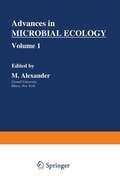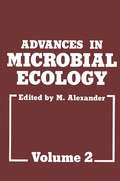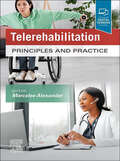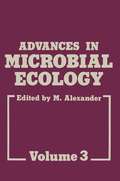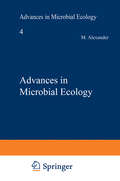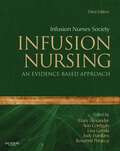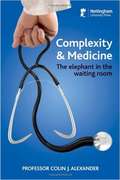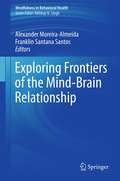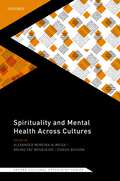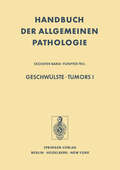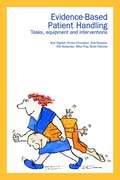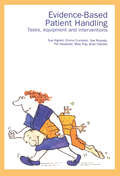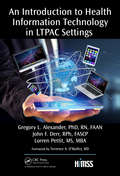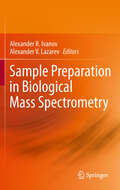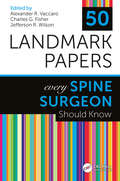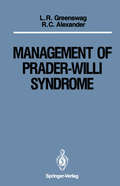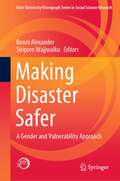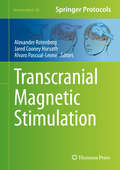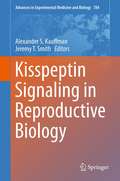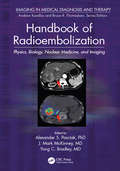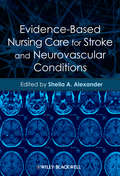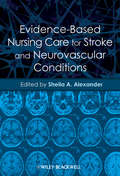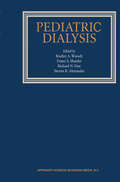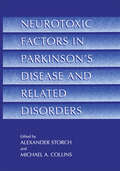- Table View
- List View
Advances in Microbial Ecology (Advances in Microbial Ecology #1)
by M. AlexanderMicrobial ecology has come of age. A long history of exploratory research and problem definition is admittedly behind us, and outstanding scientists from many regions of the world have contributed major findings to the development of the discipline. The early literature is indeed vast and impressive, yet it is still fair to say that the field is just beginning to develop in a mature fashion. The major microbial habitats and the chief inhabitants have been delineated and are only now being adequately explored; the processes that are brought about by the microscopic residents are at the present time being investigated in definitive ways; new concepts are being formulated; and novel, exciting, and useful techniques have been devised. In recognition of the emergence of microbial ecology as a rapidly growing and independent discipline, the International Commission on Microbial Ecology-a unit of the International Association of Micro biological Societies and the Division of Environmental Biology of the Inter national Union of Biological Societies-has established the Advances in Microbial Ecology and has appointed an editor and editorial board for the series. The purposes of this review series are to present in one group of volumes an overview of the information that is now spread in an enormous array of technical journals, to have authors in various areas of microbial ecology summarize and present views in depth of their own specialties, and to help promote the continued growth of microbial ecology.
Advances in Microbial Ecology: Volume 2 (Advances in Microbial Ecology #2)
by M. AlexanderThe substantial and impressive changes in microbial ecology can scarcely be chronicled in a meaningful fashion, and a review series such as Advances in Microbial Ecology can thus not do justice to the numerous studies that have been published in recent years. On the other hand, the mere existence of this series bears testimony to the many and diverse activities. The growing concern with microbial communities and processes in natural ecosystems is not restricted to scientists in one region and is not limited to particular groups of organisms or to individual theoretical or applied problems. The recent and successful international symposium on microbial ecology held in New Zealand-sponsored in part by the International Commission on Microbial Ecology, as is the Advances-and the general microbiology and ecology conferences and congresses have included reports from investigators from all corners of the globe and have explored both new and traditional areas, agricultural and public health problems, individual species and complex communities, and heterotrophs and autotrophs as well as ecosystem models relying on mathematical concepts and environmental processes needing sophisticated chemistry for their definition. The reviews in the present volume thus can offer only a minute sampling of the multitude of topics being actively explored at the present time. Two of the reviews focus attention on biogeochemical cycles regulated by microorganisms, in particular the way these organisms contribute to or control the levels and identities of chemical substances in the atmosphere. The chapter by Y. Dommergues, L. W. Belser, and E. L.
Telerehabilitation, E-Book: Principles and Practice
by Marcalee AlexanderOffering significant benefits to both healthcare providers and patients, telerehabilitation is a key component in the future of rehabilitation care. Telerehabilitation: Principles and Practice provides expert information from experienced practitioners in the field, covering the wide range of patients seen in a rehabilitation medical practice or a hospital-based system. It provides quick access to information on common rehabilitation diagnoses and practices and how you can best use telerehabilitation to provide timely, effective care to every patient. Clearly explains the benefits and utility of telerehabilitation for improving access to care and outcomes for various patient populations. Uses a reader-friendly format based on diagnosis of specific disorders and common problems. Covers telerehabilitation for spinal cord injury, stroke, and cancer rehabilitation, amongst other diagnoses. Discusses key topics in telerehabilitation such as musculoskeletal concerns, integrative health, physical and occupational therapy. Features discussions of the use of telerehabilitation for care of psychologic, bladder, bowel, and sexual concerns. Ideal for telemedicine professionals, physiatrists in practice or residency administrators, as well as physical and occupational therapists.
Advances in Microbial Ecology: Volume 3 (Advances in Microbial Ecology #3)
by Martin AlexanderWe are most gratified by the response to the initiation of this series of volumes presenting recent developments and new concepts in microbial ecology. Favorable reactions have been expressed in both oral and written communication, and Ad vances in Microbial Ecology thus seems to be providing a worthwhile outlet in a rapidly growing field of microbiology and environmental sciences. The growing importance of microbial ecology is evident in many ways. Uni versity personnel are expanding their programs and increasing the number of research topics and publications. Substantial numbers of industrial scientists have likewise entered this field as they consider the microbial transformation of chemicals in waters and soils and the effects of synthetic compounds on natural microbial communities. Agricultural, medical, dental, and veterinary practitioners and scientists have also been increasing their activity in microbial ecology because of the importance of the discipline to their own professions. In addition, govern mental agencies have expanded regulatory and research activities concerned with microbial ecology owing to the importance of information and regulations fo cused on the interactions between microorganisms in nature and particular en vironmental stresses.
Advances in Microbial Ecology (Advances in Microbial Ecology #4)
by Martin AlexanderThe literature in microbial ecology is growing rapidly. Journals in many countries dealing with microbiology, ecology, environmental sciences, and environmental technology are publishing an ever-increasing number of papers, and these reports are providing microbial ecologists with a wealth of information. This body of data is now so large and the research is published in so many journals and mono graphs that maintaining an overview of the development of the field grows more difficult. The role of Advances in Microbial Ecology thus becomes more obvious with time. The articles in the present volume encompass an array of topics appropriate to the development of the discipline of microbial ecology. Both terrestrial and aquatic ecosystems are subjects of attention, and a variety of microbiological groups come under review. Furthermore, methodological problems and ap proaches are not overlooked. The ecology of protozoa, constraints on their populations, and their role in nutrient cycling and energy flow are considered by J. D. Stout. A unique micro environment is discussed by B. Norkrans, the surface microlayer of aquatic eco systems, and Dr. Norkrans presents information on a field that has blossomed in the last few years. The subject of the review by H. S. Lowendorf is the genus Rhizobium, a group of bacteria whose importance has grown as the cost of fuel for production of nitrogen fertilizers and ultimately for protein production has increased.
Infusion Nursing - E-Book: An Evidence-Based Approach
by Mary Alexander Infusion Nurses Society Ann Corrigan Lisa Gorski Judy Hankins Roxanne PeruccaWith a new focus on evidence-based practice, the 3rd edition of this authoritative reference covers every aspect of infusion therapy and can be applied to any clinical setting. Completely updated content brings you the latest advances in equipment, technology, best practices, guidelines, and patient safety. Other key topics include quality management, ethical and legal issues, patient education, and financial considerations. Ideal as a practical clinical reference, this essential guide is also a perfect review tool for the CRNI examination.Authored by the Infusion Nurses Society, this highly respected reference sets the standard for infusion nursing practice. Coverage of all 9 core areas of INS certification makes this a valuable review resource for the examination. Material progresses from basic to advanced to help new practitioners build a solid foundation of knowledge before moving on to more advanced topics. Each chapter focuses on a single topic and can serve as a stand-alone reference for busy nursing professionals. Expanded coverage of infusion therapy equipment, product selection, and evaluation help you provide safe, effective care. A separate chapter on infusion therapy across the continuum offers valuable guidance for treating patients with infusion therapy needs in outpatient, long-term, and home-care, as well as hospice and ambulatory care centers. Extensive information on specialties addresses key areas such as oncology, pain management, blood components, and parenteral nutrition. An evidence-based approach and new Focus on Evidence boxes throughout the book emphasize the importance of research in achieving the best possible patient outcomes.The user-friendly design highlights essential information in handy boxes, tables, and lists for quick access. Completely updated coverage ensures you are using the most current infusion therapy guidelines available.
Complexity and medicine: The Elephant in the Waiting Room
by Michael AlexanderThis book takes Complexity Theory and applies it to medicine where it has previously made little ground. It provides new hypotheses for multiple common but misunderstood diseases.
Exploring Frontiers of the Mind-Brain Relationship (Mindfulness in Behavioral Health)
by Alexander Moreira-Almeida and Franklin Santana SantosThe conscious mind defines human existence. Many consider the brain as a computer, and they attempt to explain consciousness as emerging at a critical, but unspecified, threshold level of complex computation among neurons. The brain-as-computer model, however, fails to account for phenomenal experience and portrays consciousness as an impotent, after-the-fact epiphenomenon lacking causal power. And the brain-as-computer concept precludes even the remotest possibility of spirituality. As described throughout the history of humankind, seemingly spiritual mental phenomena including transcendent states, near-death and out-of-body experiences, and past-life memories have in recent years been well documented and treated scientifically. In addition, the brain-as-computer approach has been challenged by advocates of quantum brain biology, who are possibly able to explain, scientifically, nonlocal, seemingly spiritual mental states.Exploring Frontiers of the Mind-Brain Relationship argues against the purely physical analysis of consciousness and for a balanced psychobiological approach. This thought-provoking volume bridges philosophy of mind with science of mind to look empirically at transcendent phenomena, such as mystic states, near-death experiences and past-life memories, that have confounded scientists for decades. Representing disciplines ranging from philosophy and history to neuroimaging and physics, and boasting a panel of expert scientists and physicians, including Andrew Newberg, Peter Fenwick, Stuart Hameroff, Mario Beauregard, Deepak Chopra, and Chris Clarke the book rigorously follows several lines of inquiry into mind-brain controversies, challenging readers to form their own conclusions—or reconsider previous ones. Key coverage includes: Objections to reductionistic materialism from the philosophical and the scientific tradition.Phenomena and the mind-brain problem.The neurobiological correlates of meditation and mindfulness.The quantum soul, a view from physics.Clinical implications of end-of-life experiences.Mediumistic experience and the mind-brain relationship. Exploring Frontiers of the Mind-Brain Relationship is essential reading for researchers and clinicians across many disciplines, including cognitive psychology, personality and social psychology, the neurosciences, neuropsychiatry, palliative care, philosophy, and quantum physics.“This book … brings together some precious observations about the fundamental mystery of the nature of consciousness … It raises many questions that serve to invite each of us to be more aware of the uncertainty of our preconceptions about consciousness … This book on the frontiers of mind-body relationships is a scholarly embodiment of creative and open-minded science.”C. Robert Cloninger, MDWallace Renard Professor of Psychiatry, Genetics, and Psychology,Washington University School of MedicineSt. Louis MO
Spirituality and Mental Health Across Cultures (Oxford Cultural Psychiatry)
by Alexander Moreira-Almeida, Bruno Paz Mosqueiro, Dinesh BhugraReligiosity and spirituality (R/S) represent a very important factor of daily life for many individuals across different cultures and contexts. It is associated with lower rates of depression, suicide, mortality, and substance abuse, and is positively correlated with well-being and quality of life. Despite growing academic recognition and scientific literature on these connections this knowledge has not been translated into clinical practice. Part of the expanding Oxford Cultural Psychiatry series, Spirituality and Mental Health Across Cultures is a timely exploration of the implications of R/S on mental health. Written and edited by 38 experts in the fields of spirituality and mental health from 11 countries, covering a wide range of cultural and geographical perspectives, this unique resource assesses how mental health relates to world religions, agnosticism, atheism, and spiritualism unaffiliated with organised religion, with a practical touch. Across 25 chapters, this resource provides readers with a succinct and trustworthy review of the latest research and how this can be applied to clinical care. The first section covers the principles and fundamental questions that relate science, history, philosophy, neuroscience, religion, and spirituality with mental health. The second section discusses the main beliefs and practices related to world religions and their implications to mental health. The third reviews the impact of R/S on specific clinical situations and offers practical guidance on how to handle these appropriately, such as practical suggestions for assessing and integrating R/S in personal history anamnesis or psychotherapy.
Geschwülste / Tumors I: Morphologie, Epidemiologie, Immunologie / Morphology, Epidemiology, Immunology (Handbuch der allgemeinen Pathologie #6 / 5)
by P. Alexander G. Chomette H. Hamperl D. K. Hossfeld L. G. Koss R. Laumonier H. F. Oettgen M. F. Rajewsky A. A. Sandberg L. H. Sobin H. Tulinius S. WatanabeEvidence-Based Patient Handling: Techniques and Equipment
by Pat Alexander Emma Crumpton Brian Fletcher Mike Fray Sue Hignett Sue RuszalaProviding care and treatment for patients usually requires moving and handling activities associated with high rates of back injuries. The personal and financial cost of back pain and injuries to health staff means there is an urgent need to improve practice in this area. Over the past twenty years a number of guidelines have been published, however, these have been based on professional consensus rather than evidence. Evidence-Based Patient Handling tackles the challenge of producing an evidence base to support clinical practice and covers tasks, equipment and interventions. This book questions previously held opinions about moving and handling and provides the foundation for future practice.
Evidence-Based Patient Handling: Techniques and Equipment
by Pat Alexander Emma Crumpton Brian Fletcher Mike Fray Sue Hignett Sue RuszalaProviding care and treatment for patients usually requires moving and handling activities associated with high rates of back injuries. The personal and financial cost of back pain and injuries to health staff means there is an urgent need to improve practice in this area. Over the past twenty years a number of guidelines have been published, however, these have been based on professional consensus rather than evidence. Evidence-Based Patient Handling tackles the challenge of producing an evidence base to support clinical practice and covers tasks, equipment and interventions. This book questions previously held opinions about moving and handling and provides the foundation for future practice.
An Introduction to Health Information Technology in LTPAC Settings (HIMSS Book Series)
by Gregory L. Alexander, PhD, RN, FAAN Derr F. John, RPh, FASCP Lorren Pettit, MS, MBAA multiplicity of factors converging together suggest the long term/post-acute care (LTPAC) provider community (e.g. nursing homes, behavioral health facilities, home health agencies, etc.) will accelerate in importance within the healthcare ecosystem during the next few years. The challenge for many LTPAC providers in this emerging environment will be to advance their clinical health information technologies (health IT) capabilities in order to "play" with other providers in the healthcare "sandbox." This book is designed to assist LTPAC leaders in identifying and exploring the array of critical issues one needs to consider in order to operate within an advanced clinical health IT ecosystem. This book surveys key issues surrounding the use of clinical health IT in LTPAC settings, to include providing readers with a suggested strategic plan and roadmap for selecting and installing digital health technologies in LTPAC organizations. Though the focus of the book primarily centers on the U.S. LTPAC provider’s experience, the authors also spend time addressing global and future LTPAC considerations.
An Introduction to Health Information Technology in LTPAC Settings (HIMSS Book Series)
by Gregory L. Alexander, PhD, RN, FAAN Derr F. John, RPh, FASCP Lorren Pettit, MS, MBAA multiplicity of factors converging together suggest the long term/post-acute care (LTPAC) provider community (e.g. nursing homes, behavioral health facilities, home health agencies, etc.) will accelerate in importance within the healthcare ecosystem during the next few years. The challenge for many LTPAC providers in this emerging environment will be to advance their clinical health information technologies (health IT) capabilities in order to "play" with other providers in the healthcare "sandbox." This book is designed to assist LTPAC leaders in identifying and exploring the array of critical issues one needs to consider in order to operate within an advanced clinical health IT ecosystem. This book surveys key issues surrounding the use of clinical health IT in LTPAC settings, to include providing readers with a suggested strategic plan and roadmap for selecting and installing digital health technologies in LTPAC organizations. Though the focus of the book primarily centers on the U.S. LTPAC provider’s experience, the authors also spend time addressing global and future LTPAC considerations.
Sample Preparation in Biological Mass Spectrometry
by Alexander R. Ivanov and Alexander V. LazarevThe aim of this book is to provide the researcher with important sample preparation strategies in a wide variety of analyte molecules, specimens, methods, and biological applications requiring mass spectrometric analysis as a detection end-point. In this volume we have compiled the contributions from several laboratories which are employing mass spectrometry for biological analysis. With the latest inventions and introduction of highly sophisticated mass spectrometry equipment sample preparation becomes an extremely important bottleneck of biomedical analysis. We have a goal of giving the reader several successful examples of sample preparation, development and optimization, leading to the success in analytical steps and proper conclusions made at the end of the day. This book is structured as a compilation of contributed chapters ranging from protocols to research articles and reviews. The main philosophy of this volume is that sample preparation methods have to be optimized and validated for every project, for every sample type and for every downstream analytical technique.
50 Landmark Papers Every Spine Surgeon Should Know (50 Landmark Papers)
by Alexander R. Vaccaro, Charles G. Fisher and Jefferson R. WilsonThere has been an exponential increase in the volume and quality of published research relating to spine care over the last several decades. Among thousands of articles, a small fraction has been shown to be truly "game changing," forcing the entire field to pause and take notice. These landmark studies may describe a new procedure or surgical approach, evaluate the relative effects of known treatments or techniques, introduce a new classification system, or provide new insights into natural history or disease prognosis. Such studies form the foundations of spine surgery today.This book will be a useful reference not only to the established spine surgeon, but also to neurosurgery and orthopedic residents, as well as to spine surgery fellows as they continue to fortify their knowledge surrounding spinal disorders. Further, this will no doubt serve as a useful evidence-based resource for trainees studying for professional examinations and perhaps most importantly challenge and inspire clinicians to produce high-quality impactful research.
Management of Prader-Willi Syndrome: Under the Sponsorship of The Prader-Willi Syndrome Association
by Randell C. Alexander Louise R. GreenswagManagement of Prader-Willi Syndrome is the first book to provide a comprehensive source of knowledge about Prader-Willi Syndrome and to offer common-sense guidelines for management. It consists of contributions from professionals in many health and allied disciplines who have worked with this special population. The book focuses on clinical, social, familial, and community issues related to care. It is directed to health, education, and other specialists in academic, clinical, and community settings. Management of Prader-Willi Syndrome describes strategies for management which are appropriate to an interdisciplinary approach.
Making Disaster Safer: A Gender and Vulnerability Approach (Kobe University Monograph Series in Social Science Research)
by Ronni Alexander Siriporn WajjwalkuThis edited book was produced through a transnational and transdisciplinary UNESCO Chair Project on Gender and Vulnerability in Disaster Risk Reduction Support. Contributors come from five disaster-prone Asian countries, and the chapters reflect their rich knowledge and practical experience in disaster management and humanitarian assistance. The chapters, all with a focus on gender and vulnerability, illustrate that gender can make people, especially women, vulnerable. The chapters address the experiences of state and non-state actors responding to disaster and promoting recovery at the local level. However, while women and vulnerable people may be victims of disasters, they also serve as agents for recovery and voices for better disaster preparedness. In sharing both successes and failures, as well as suggestions for the future, this book speaks to the need for transdisciplinary knowledge and multilevel coordination, as well as full equality for all genders and respect for human rights, in order to cope with increasingly more frequent, intense, and complex emergencies. This book is of interest as a text to students in a variety of disciplines who are focusing on disaster and health emergencies, as well as to practitioners and others promoting disaster risk reduction and resilience.
Transcranial Magnetic Stimulation (Neuromethods #89)
by Alexander Rotenberg, Jared Cooney Horvath and Alvaro Pascual-LeoneTranscranial Magnetic Stimulation seeks to enable new and existing practitioners to learn and follow established TMS protocols. The individual chapters in this detailed volume describe methods for single and multiple pulse TMS as well as methods for TMS coupled with associated techniques, from electromyography to neuroimaging. The collection promises to facilitate growth and exploration of clinical and experimental TMS. As a volume in the popular Neuromethods series, chapters include the kind of expert implementation advice that encourages successful and reproducible results.Authoritative and practical, Transcranial Magnetic Stimulation will serve not only as a good methodological introduction for those new to this growing field, but also as a source of continual reference for experienced practitioners when re-visiting older, exploring novel, or developing new concepts.
Kisspeptin Signaling in Reproductive Biology (Advances in Experimental Medicine and Biology #784)
by Alexander S. Kauffman and Jeremy T. SmithKisspeptin has been shown to be both necessary and sufficient for activation of the reproductive axis, during puberty and later in adulthood. This makes kisspeptin a fundamental component of the reproductive axis. Kisspeptin has been deemed the single most potent stimulator of GnRH neurons yet known. The importance of kisspeptin has been documented in humans as well as non-human animal models, ranging from monkeys, sheep, and rodents to numerous fish species, thus signifying a highly conserved nature of its reproductive function. Importantly, kisspeptin neurons seem to mediate many of the regulatory effects of other signals, whether they are metabolic, circadian, hormonal, or stress. This places kisspeptin neurons in a unique position to be key nodal points and conduits for conveying numerous endogenous and exogenous signals to the reproductive axis.
Handbook of Radioembolization: Physics, Biology, Nuclear Medicine, and Imaging (Imaging in Medical Diagnosis and Therapy)
by Alexander S. Pasciak, J. Mark McKinney and Yong C. BradleyRadioembolization is a widely used treatment for non-resectable primary and secondary liver cancer. This handbook addresses the radiation biology, physics, nuclear medicine, and imaging for radioembolization using Yttrium-90 (90Y) microspheres, in addition to discussing aspects related to interventional radiology. The contents reflect on and off-label treatment indications, dose-response relationships, treatment-planning, therapy optimization, radiation safety, imaging follow-up and many other facets of this therapy necessary for both novice and advanced users alike.
Evidence-Based Nursing Care for Stroke and Neurovascular Conditions
by Sheila A. AlexanderWith the aging population ever growing, healthcare for persons suffering from stroke and related illnesses is increasingly important. Evidence-Based Nursing Care for Stroke and Neurovascular Conditions provides a comprehensive and practical guide for novice, experienced and advanced practice nurses working with patients suffering from stroke and other neurovascular conditions. With a focus specifically on neurovascular disorders, this highly detailed text offers easy-to-find information on evidence-based care guidelines. The book begins with a thorough introduction to normal cerebrovascular anatomy and physiology and common pathologic mechanisms, describing the unique challenges in working with this patient group. Later chapters provide the pathophysiology, diagnostic and current nursing interventions for the care of patients with neurovascular disorders including transient ischemic attacks, ischemic stroke, hemorrhagic stroke, Moyamoya, Migraines and more. Evidence-Based Nursing Care for Stroke and Neurovascular Conditions is a must-have resource for practitioners caring for patients enduring stroke and other neurovascular conditions.
Evidence-Based Nursing Care for Stroke and Neurovascular Conditions
by Sheila A. AlexanderWith the aging population ever growing, healthcare for persons suffering from stroke and related illnesses is increasingly important. Evidence-Based Nursing Care for Stroke and Neurovascular Conditions provides a comprehensive and practical guide for novice, experienced and advanced practice nurses working with patients suffering from stroke and other neurovascular conditions. With a focus specifically on neurovascular disorders, this highly detailed text offers easy-to-find information on evidence-based care guidelines. The book begins with a thorough introduction to normal cerebrovascular anatomy and physiology and common pathologic mechanisms, describing the unique challenges in working with this patient group. Later chapters provide the pathophysiology, diagnostic and current nursing interventions for the care of patients with neurovascular disorders including transient ischemic attacks, ischemic stroke, hemorrhagic stroke, Moyamoya, Migraines and more. Evidence-Based Nursing Care for Stroke and Neurovascular Conditions is a must-have resource for practitioners caring for patients enduring stroke and other neurovascular conditions.
Pediatric Dialysis
by Steven R. Alexander Richard N. Fine Franz S. Schaefer Bradley A. WaradyThe provision of optimal dialysis therapy to children requires a thorough understanding of the multi-disciplinary manner in which the pediatric patient is affected by renal insufficiency. Knowledge of the technical aspects of peritoneal dialysis, hemodialysis and continuous renal replacement therapy must be complemented by attention to issues such as anemia, renal osteodystrophy, hypertension, growth, cognitive development, nutrition, nursing care and the psychosocial adaptation of the child and family to chronic disease. The inaugural edition of Pediatric Dialysis provides a comprehensive review of these and other related topics with a singular emphasis on the unique aspects of their application to children. With authoritative, clinically relevant, well-referenced chapters written by a host of recognized international experts who emphasize key aspects of contemporary management, Pediatric Dialysis has been designed to serve as a primary resource to all clinicians involved in the care of the pediatric dialysis patient.
